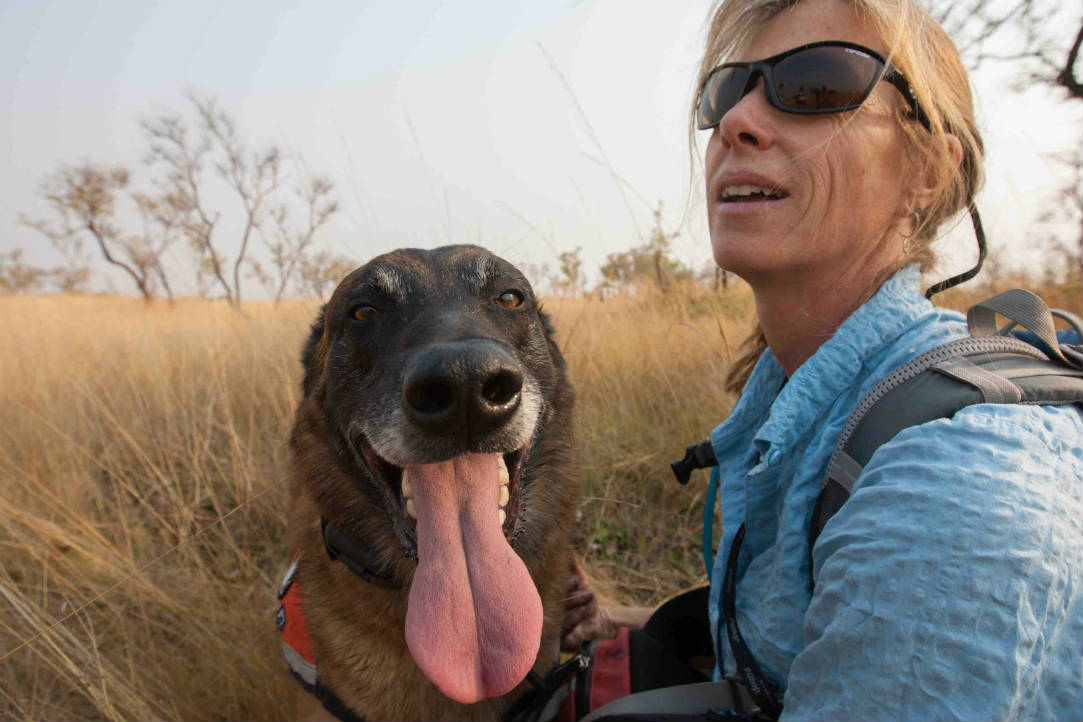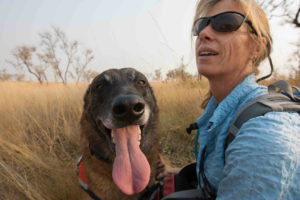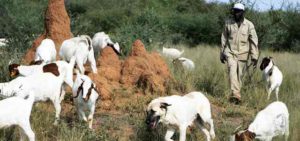
Dogs are amazing. They are lovable, loyal, and protective. And, it turns out, heroes of conservation.
Working Dogs for Conservation (WD4C) loves bad dogs – the obsessive high-energy kind. Of the approximately one million dogs euthanized in shelters across the country each year, Megan Parker and her partners at WD4C rescue handfuls of those dogs that few others want.
These dogs don’t just get rescued; they get to work, putting their special high- energy skills to use in an array of conservation-related activities. From sniffing out arms and ammunition used by poachers in Zambia, to detecting invasive weeds before they break the surface in Montana, these dogs become heroes that would otherwise have been killed, but for Parker’s efforts.

Parker and her colleagues select dogs with an over-the-top desire to play with a toy. “The ones we choose are high speed, hell to live with, high energy, and obsessive-compulsive. They will do anything to fetch or tug.”
To train the dogs, Parker links the scent of whatever target she’s training the dog on, be it ivory, ammunition, or invasive weeds, with a reward, usually a ball or a tug toy. “All of our training is positive. We link what they love with what we want them to find.”
When they find and train the right dog, Parker says, “The dog loves it. When it loves what it’s doing and has focus and drive, we keep it busy.”
She and her colleagues train dogs that get placed in countries as far away as Zambia. These dogs are trained to detect pangolin scales, leopard skins, lion, mokula lumber, gunpowder, elephant ivory, rhino horn, illegal ammunition, and illegal bush meat species.
*****
DOG HEROES FOR CHEETAHS
The world cheetah population has dropped from 100,000 to ten thousand over the past one hundred years. While the story of their population decline is similar to that of other species across the globe one of their challenges has to do with the cheetah’s greatest asset: its speed.
A cheetah can accelerate to seventy miles per hour in just three seconds. With special claws that work like cleats; a tail used as a rudder; long limber legs; a flexible backbone; an expanded nasal cavity for greater air intake; and enlarged arteries, lungs, and heart, the cheetah is an aerodynamic wonder of unparalleled speed.
However, because they are built for speed and not for power, cheetahs have trouble competing with larger and more powerful cats that will often steal a cheetah’s prey and kill their young.
One way cheetahs have dealt with this obstacle is by living outside of game reserves where many of their competitors are found. Consequently, 90 percent of Namibia’s cheetahs reside outside of protected areas, alongside humans, many of whom are farmers that see the cheetah as competition for their livestock.
When Laurie Marker moved to Namibia to start the Cheetah Conservation Fund (CCF), her first task was to sit with farmers and to listen.
Livestock farmers had killed nearly half of Africa’s most endangered big cat, and Marker was all about finding solutions.
“The most difficult part of doing this job is balancing all of the interests of the people involved—the politics of keeping everyone happy. And with cheetahs we will not solve the conservation crisis unless all stakeholders have a voice in the solution.”
Keeping everyone happy and giving all stakeholders a voice means caring about livestock farmers (in an arid environment with regular drought, livestock farming is the main form of livelihood) whose decision to pull the trigger could mean one less endangered cat.
“You can’t ask a farmer to care about conserving wildlife when he’s struggling just to feed his family,” says Marker. That’s why one of CCF’s signature programs is Future Farmers of Africa, a human-wildlife conflict mitigation initiative. This program works with farmers to find predator-friendly livestock and wildlife management techniques.
One such technique Marker pioneered in Namibia is the use of Anatolian shepherds and Kangal dogs, physically imposing dogs originally from Turkey.
The dogs, whom Marker carefully selects, are highly intelligent, protective of the livestock, and able to drive away most large predators. Farmers who have used Anatolian and Kangal dogs to protect their herds have reported drops in predation rates of between 80 and 100 percent—meaning those farmers are less likely to kill or trap cheetahs on their lands. Farmers, in fact, are so enthusiastic about the program that there is a two-year waiting list for puppies.

Excerpts for this post were taken from the new book, Wild Lives, Leading Conservationists on the Animals and Planet They Love. Laurie Marker and Megan Parker, who are both using dogs for conservation, are two of the twenty conservationists featured in the book who are saving species across the globe.
